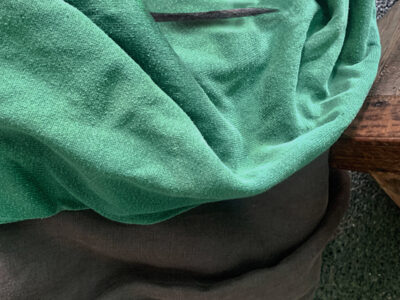Allergen
Dust Mites
It’s not the bite of this arachnid that’s the main issue but its waste — more specifically, the membrane that surrounds the mite’s fecal pellets. The chitin in its hard exoskeleton is also an aeroallergen (airborne allergen). We come into contact with it when immature mites shed their exoskeletons. This means that exposure can be via ingestion, inhalation, or direct contact with the eyes or skin.
A contact allergy to house dust mites can be complicated because it can coexist with an IgE-mediated allergy and reactions can be especially severe for those with atopic dermatitis (eczema) and related conditions like asthma, allergic rhinitis, and allergic conjunctivitis. An additional concern is a secondary bacterial or other microbial infection after scratching (repetitive scratching can cause breaks in the skin which opportunistic microbes can enter).
These overlapping syndromes can make therapy resistant or difficult. Topical anti-inflammatory steroids may not be effective and systemic immunomodulatory treatment may be required in addition to meticulous cleaning and lifestyle choices (see below) to prevent exposure.
Because of the possibility of coexisting syndromes, testing for house dust mite allergy is done with both a patch test and other IgE test such as a prick test and/or ImmunoCAP blood test for Der p1/Der f1 (cysteine proteases), Der p2/Der f2 (lipid-binding auto-adjuvants), and Der p10 (where a cross reaction with chitin in crustaceans and cockroaches may also be present) or more.
If you have atopic dermatitis, the proteases in house dust mites can disrupt the skin barrier function and lead to hypersensitivity reactions, delayed skin barrier repair and severe itching, as well as other types of inflammation.
Dust mites can’t survive in very cold temperatures or where there is low humidity. They do exist in tropical and temperate zones and they love our pillowcases and other bedding, carpets, cushions, curtains, furniture, plush toys, and even clothing, and are avid fans of sheepskin. Exposure can be direct (such as when coming into contact with clothing, plush toys, or pillows) or airborne after opening up old boxes, cupboards, vacuuming, dusting, making a bed, or during construction or remodeling.
You’ll tend to see reactions on the most exposed areas of the skin such as the face and arms, and possibly more in the summer.
What to do? Be meticulous about …
- Laundry: wash clothing, curtains, plush toys, and linens in hot water. If you’ve patch-tested positive to other allergens, try an allergen-free laundry soap like Fawn & Launder or even one of our hair and body shampoos. Use the high-heat setting in the dryer, too, if possible. For items that are too delicate for laundry, try keeping them in a plastic bag in the freezer overnight.
- Frequent vacuuming (not just of floors but also cushions, furniture surfaces, and window treatments), especially with dust-free (some are water-based), deep-reaching vacuums. If professional cleaning is an option, have this done at regular intervals.
- Use diluted tea to wipe off dust-collecting surfaces.
- Consider not using carpets or rugs, or limiting them to areas where you do not spend lots of time.
- If you have access to air conditioning, keeping it on when you sleep may help due to the lower humidity and colder temperature (house dust mites like humidity levels above 75% and warmer weather). Just remember to clean the AC filter regularly.
- Try using a dehumidifier.
- Because dry, cold air can be harmful to the skin’s barrier layer, it is important to be extra careful about using personal care products — hair care, body soap, cleanser, skincare, makeup, and everything else — without your contact allergens, and to prioritize layering barrier-reparative moisturizers. Try Know-It-Oil followed by Mommycoddling All-Over Lotion then Boo-Boo Balm.
- Use allergen-impermeable mattresses, cushions, pillow covers, bedding, etc.
- If you need to do activity that requires lots of dust exposure such as cleaning up a basement, going through belongings for donation, or remodeling, wear protective gear like a mask, goggles, long sleeves. Apply mineral barrier-protective product like Stay-On-Point! or Armada Baby or Post-Procedure thickly on exposed skin. Try doing the work in shorter spurts to limit your exposure. Or ask for help: maybe an extra pair of hands can take care of unearthing and dusting old items and you can handle carrying, organizing, and labeling them. Bathe immediately after and follow with your layered barrier-repairing and protective skincare products.
- Talk to both your dermatologist and allergist about other treatment and management options.
Subscribe to VMVinSKIN.com and our YouTube channel for more hypoallergenic tips and helpful “skinformation”!
If you have a history of sensitive skin…
…don’t guess! Random trial and error can cause more damage. Ask your dermatologist about a patch test.
To shop our selection of hypoallergenic products, visit vmvhypoallergenics.com. Need help? Ask us in the comments section below, or for more privacy (such as when asking us to customize recommendations for you based on your patch test results) contact us by email, or drop us a private message on Facebook.
For more:
- On the prevalence of skin allergies, see Skin Allergies Are More Common Than Ever.
- For the difference between irritant and allergic reactions, see It’s Complicated: Allergic Versus Irritant Reaction.
- For the difference between food, skin, and other types of reactions: see Skin & Food Allergies Are Not The Same Thing.
- On the differences between hypoallergenic, natural, and organic, check out Is Natural Hypoallergenic? and this video in our YouTube channel.
- To learn about the VH-Rating System and hypoallergenicity: What Is The Validated Hypoallergenic Rating System?
Main References:
Regularly published reports on the most common allergens by the North American Contact Dermatitis Group and European Surveillance System on Contact Allergies (based on over 28,000 patch test results, combined), plus other studies. Remember, we are all individuals — just because an ingredient is not on the most common allergen lists does not mean you cannot be sensitive to it, or that it will not become an allergen. These references, being based on so many patch test results, are a good basis but it is always best to get a patch test yourself.
- DeKoven JG, Silverberg JI, Warshaw EM, Atwater AR, et al. North American Contact Dermatitis Group Patch Test Results: 2017-2018. Dermatitis. 2021 Mar-Apr 01;32(2):111-123.
- DeKoven JG, Warshaw EM, Zug KA, et al. North American Contact Dermatitis Group Patch Test Results: 2015-2016. Dermatitis. 2018 Nov/Dec;29(6):297-309.
- DeKoven JG, Warshaw EM, Belsito DV, et al. North American Contact Dermatitis Group Patch Test Results 2013-2014. Dermatitis. 2017 Jan/Feb;28(1):33-46.
- Warshaw, E.M., Maibach, H.I., Taylor, J.S., et al. North American contact dermatitis group patch test results: 2011-2012. Dermatitis. 2015; 26: 49-59.
- W Uter et al. The European Baseline Series in 10 European Countries, 2005/2006–Results of the European Surveillance System on Contact Allergies (ESSCA). Contact Dermatitis 61 (1), 31-38.7 2009.
- Wetter, DA et al. Results of patch testing to personal care product allergens in a standard series and a supplemental cosmetic series: An analysis of 945 patients from the Mayo Clinic Contact Dermatitis Group, 2000-2007. J Am Acad Dermatol. 2010 Nov;63(5):789-98.
- Warshaw EM, Buonomo M, DeKoven JG, et al. Importance of Supplemental Patch Testing Beyond a Screening Series for Patients With Dermatitis: The North American Contact Dermatitis Group Experience. JAMA Dermatol. 2021 Dec 1;157(12):1456-1465.
- Verallo-Rowell VM. The validated hypoallergenic cosmetics rating system: its 30-year evolution and effect on the prevalence of cosmetic reactions. Dermatitis 2011 Apr; 22(2):80-97.
- Ruby Pawankar et al. World Health Organization. White Book on Allergy 2011-2012 Executive Summary.
- Misery L et al. Sensitive skin in the American population: prevalence, clinical data, and role of the dermatologist. Int J Dermatol. 2011 Aug;50(8):961-7.
- Warshaw EM1, Maibach HI, Taylor JS, Sasseville D, DeKoven JG, Zirwas MJ, Fransway AF, Mathias CG, Zug KA, DeLeo VA, Fowler JF Jr, Marks JG, Pratt MD, Storrs FJ, Belsito DV. North American contact dermatitis group patch test results: 2011-2012.Dermatitis. 2015 Jan-Feb;26(1):49-59.
- Warshaw, E et al. Allergic patch test reactions associated with cosmetics: Retrospective analysis of cross-sectional data from the North American Contact Dermatitis Group, 2001-2004. J AmAcadDermatol 2009;60:23-38.
- Foliaki S et al. Antibiotic use in infancy and symptoms of asthma, rhinoconjunctivitis, and eczema in children 6 and 7 years old: International Study of Asthma and Allergies in Childhood Phase III. J Allergy Clin Immunol. 2009 Nov;124(5):982-9.
- Kei EF et al. Role of the gut microbiota in defining human health. Expert Rev Anti Infect Ther. 2010 Apr; 8(4): 435–454.
- Thavagnanam S et al. A meta-analysis of the association between Caesarean section and childhood asthma. Clin Exp Allergy. 2008;38(4):629–633.
- Marks JG, Belsito DV, DeLeo VA, et al. North American Contact Dermatitis Group patch-test results, 1998 to 2000. Am J Contact Dermat. 2003;14(2):59-62.
- Warshaw EM, Belsito DV, Taylor JS, et al. North American Contact Dermatitis Group patch test results: 2009 to 2010. Dermatitis. 2013;24(2):50-99.
- Verallo-Rowell V. M, Katalbas S.S. & Pangasinan J. P. Natural (Mineral, Vegetable, Coconut, Essential) Oils and Contact Dermatitis. Curr Allergy Asthma Rep 16,51 (2016) . https://doi.org/10.1007/s11882-016-0630-9.
- Park G, Oh DS, Lee MG, Lee CE, Kim YU. 6-Shogaol, an active compound of ginger, alleviates allergic dermatitis-like skin lesions via cytokine inhibition by activating the Nrf2 pathway. Toxicol Appl Pharmacol. 2016 Nov 1;310:51-59. doi: 10.1016/j.taap.2016.08.019. Epub 2016 Aug 22. PMID: 27562088.
- de Groot AC. Monographs in Contact Allergy, Volume II – Fragrances and Essential Oils. Boca Raton, FL: CRC Press Taylor & Francis Group; 2019.
- De Groot AC. Monographs in Contact Allergy Volume I. Non-Fragrance Allergens in Cosmetics (Part I and Part 2). Boca Raton, Fl, USA: CRC Press Taylor and Francis Group, 2018.
- Zhu TH, Suresh R, Warshaw E, et al. The Medical Necessity of Comprehensive Patch Testing. Dermatitis. 2018 May/Jun;29(3):107-111.
Want more great information on contact dermatitis? Check out the American Contact Dermatitis Society, Dermnet New Zealand, the Contact Dermatitis Institute, and your country’s contact dermatitis association.

Laura is our “dew”-good CEO at VMV Hypoallergenics and eldest daughter of VMV’s founding dermatologist-dermatopathologist. She has two children, Madison and Gavin, and works at VMV with her sister CC and husband Juan Pablo (Madison and Gavin frequently volunteer their “usage testing” services). In addition to saving the world’s skin, Laura is passionate about health, inclusion, cultural theory, human rights, happiness, and spreading (like a VMV cream!) goodness!




[…] the walls means lots and lots of dust on almost every surface including his clothes and bedding. Dust mite allergies can be brutal on skin and tend to coexist with other allergies like asthma and allergic […]